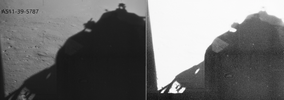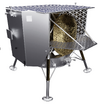What.....

NASA
1 day ago -
Peregrine Mission 1 (TO2-AB)
Description

Peregrine Mission One PDF

NASA
1 day ago -
Peregrine Mission 1 (TO2-AB)
Description

Astrobotic has posted a message that "At this time the goal is to get Peregrine as close to lunar distance as we can before it loses the ability to maintain its Sun-pointing position and subsequently loses power."
Peregrine Mission 1 (TO2-AB), or the Peregrine Lunar Lander, carrying scientific and other payloads to the Moon, was planned to touch down on the lunar surface on Sinus Viscositatis. The scientific objectives of the mission are to study the lunar exosphere, thermal properties and hydrogen abundance of the lunar regolith, magnetic fields, and the radiation environment. It will also test advanced solar arrays. Peregrine Mission 1 was selected through NASA's Commercial Lunar Payload Services (CLPS) initiative, in which NASA contracts with a commercial partner, in this case Astrobotic, that provides the launch and lander.
Spacecraft and Subsystems
Peregrine Mission 1 is about 1.9 m high and roughly 2.5 m across. It is a box-shaped main body sitting on four landing legs. The main structural landing bus is composed of aluminum isogrid shear panels and aluminum honeycomb mounting surfaces with one primary deck divided into four parts. Propulsion is provided by five TALOS-150 667-N thrusters mounted on the bottom of the lander. They use a hypergolic system of Mono-Methyl Hydrazine (MMH) fuel and dinitrogen tetroxide/nitrogen dioxide, 25% Mixed Oxides of Nitrogen (MON-25) oxidizer. Four sets of three 45-N attitude control thrusters maintain orientation. Attitude knowledge is provided by Sun and star trackers, inertial measurement, and Doppler radio and LIDAR, with the landing sensors mounted on the bottom of the bus.
Power (at 28 V, max. 480 W) is generated by GaInP/GaAs/Ge triple junction solar cells mounted on the top of the lander on a 1.8 square meter panel, and is stored in lithium-ion batteries with a capacity of 840 Whr. Communications (X-band downlink, S-band uplink) are via a medium gain, low-gain, and WLAN antennas. Thermal control is achieved by radiators and multi-layer insulation blankets.
The mission will carry about 20 payloads of various types, the lander has a payload mass capacity of 90 kg. The scientific payload includes the Laser Retro-Reflector Array (LRA), Linear Energy Transfer Spectrometer (LETS), Near-Infrared Volatile Spectrometer System (NIRVSS), Peregrine Ion-Trap Mass Spectrometer (PITMS), and Neutron Spectrometer System (NSS). Five other science payloads were originally planned for Peregrine Mission 1, but are being reallocated to other future lunar delivery missions. These are: Photovoltaic Investigation on Lunar Surface (PILS), Mass Spectrometer Observing Lunar Operations (MSolo), and Neutron Measurements at the Lunar Surface (NMLS), Fluxgate Magnetometer (MAG), and Surface Exosphere Alterations by Landers (SEAL).
Mission Profile
Launch took place from Cape Canaveral, Florida on a United Launch Alliance Vulcan Centaur rocket in the VC2S configuration, with 2 GEM-63XL solid boosters, a standard short faring, and two RL10 engines in the Centaur upper stage on 8 January 2024 at 07:18 UT. However, there was a "failure within the propulsion system", according to a message from Astrobotic. Astrobotic has posted a message that "At this time the goal is to get Peregrine as close to lunar distance as we can before it loses the ability to maintain its Sun-pointing position and subsequently loses power." indicating the original planned Moon landing will not be possible. It is currently in a highly elliptical Earth orbit and will make a close swingby of Earth on 19 January.
The original mission plan was as follows: After separation, an Earth orbit period, and cruise to the Moon, the lunar orbit phase starts. It will consist of a high, medium, and finally a circular 100 km altitude orbit. Peregrine will descend from this orbit and land in Sinus Viscositatis (Bay of Stickiness) adjacent to the Gruitheisen Domes on the northeast border of Oceanus Procellarum (Ocean of Storms). It is planned to land on February 23, shortly after local sunrise, and to operate for about 10 Earth days.
For more on NASA's CLPS initiative and missions, see:

Commercial Lunar Payload Services (CLPS) Deliveries - NASA Science
NASA is sending Commercial Lunar Payload Services (CLPS) deliveries to the Moon to address Decadal-derived science priorities.science.nasa.gov
Image credit: Astrobotic Technology
Peregrine Mission One PDF

Last edited by a moderator:





 I am joking, sort of, but it is very consistent with Russian innate distrust of authorities, either Soviet/Russian or foreign.
I am joking, sort of, but it is very consistent with Russian innate distrust of authorities, either Soviet/Russian or foreign.